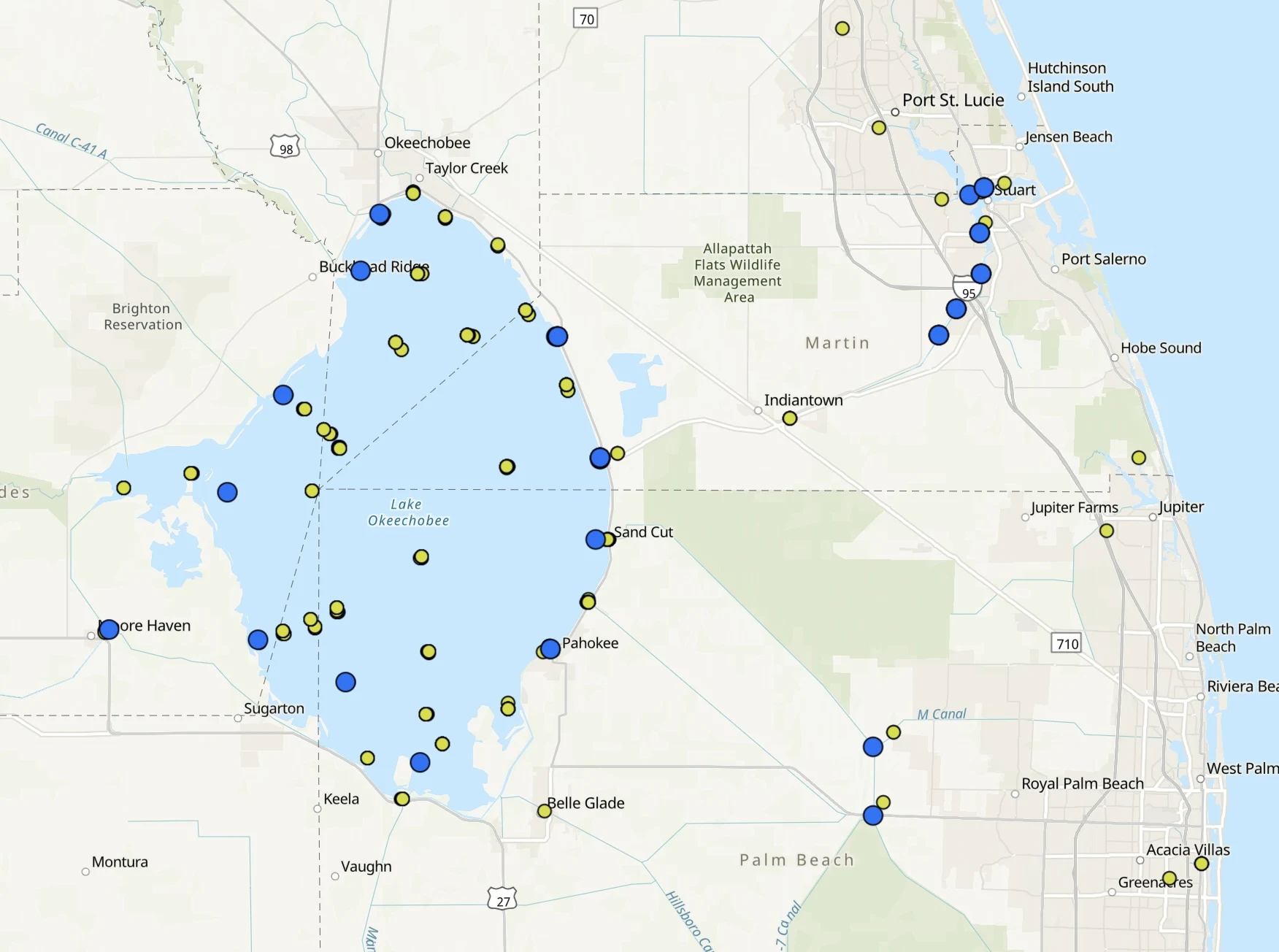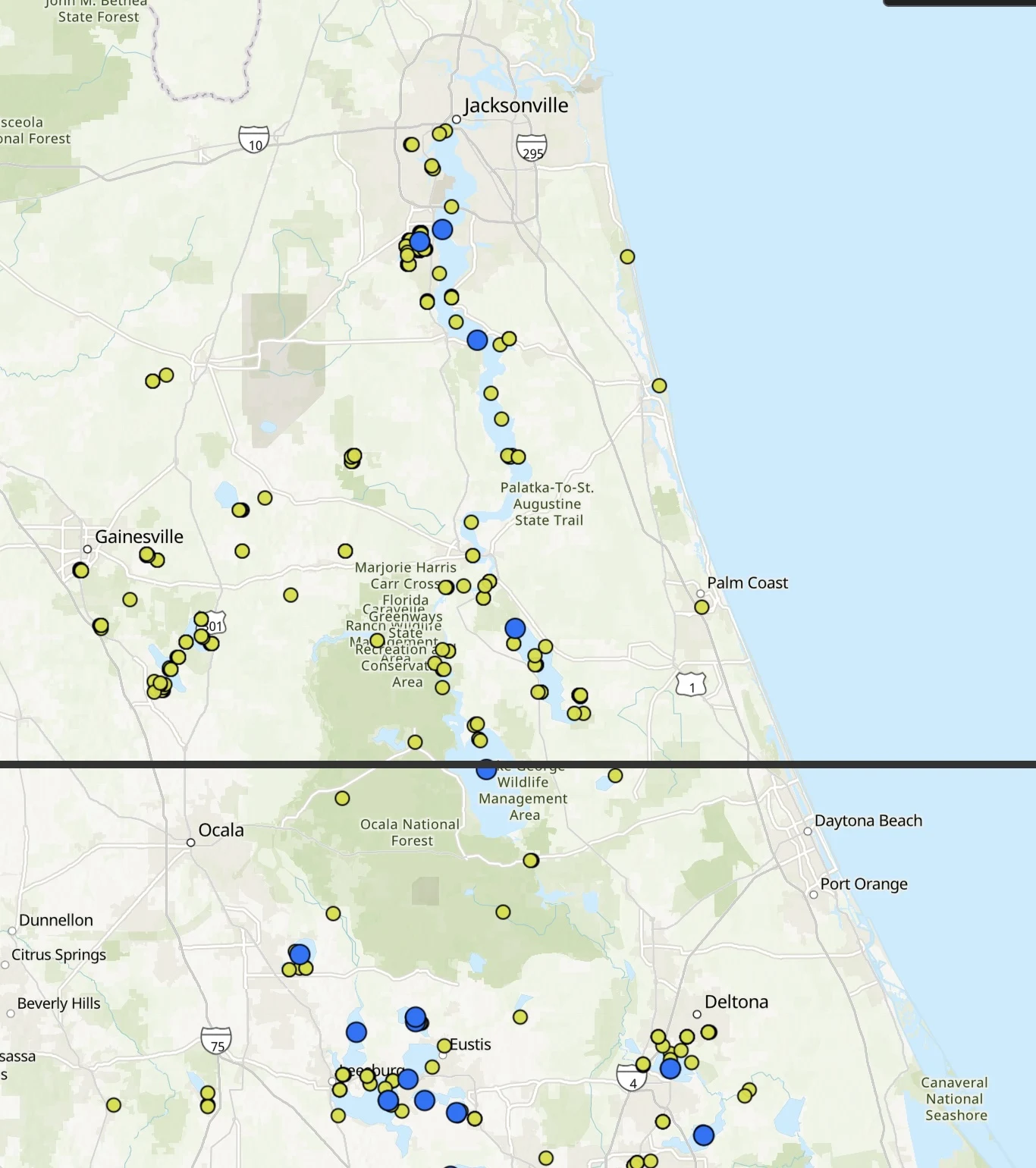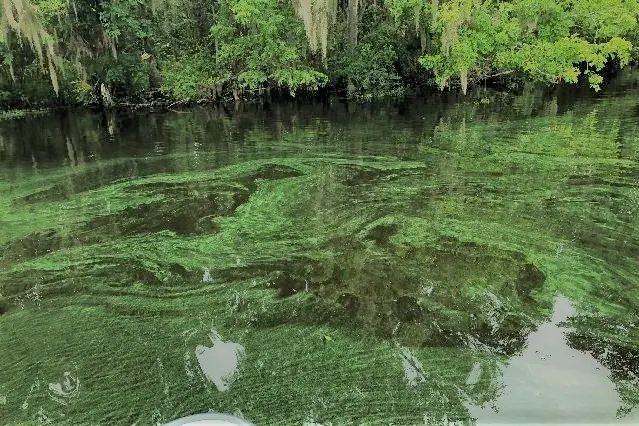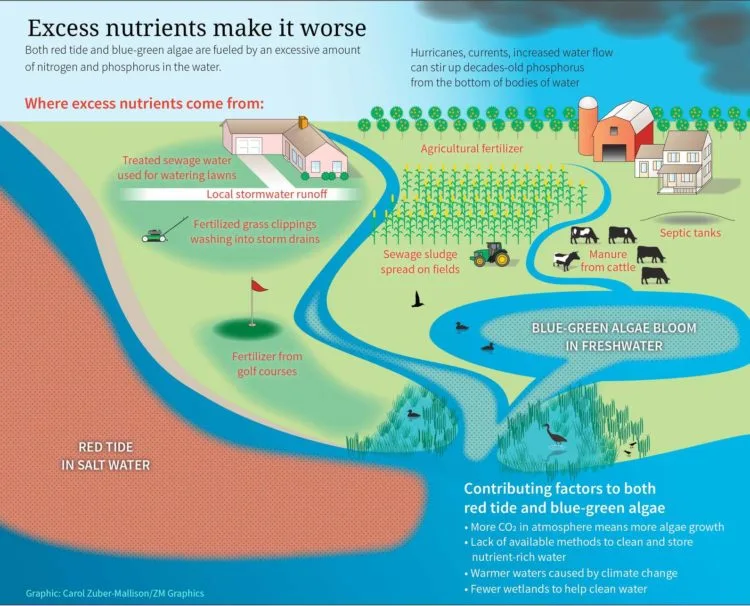The U.S. Army Corp of Engineers began discharging water from Lake Okeechobee into the Caloosahatchee and St. Lucie estuaries in mid-February. These annual discharges are intended to manage lake levels ahead of Florida’s rainy season, and they often result in blue-green algae growth in coastal estuaries.
News Reports
- ‘It’s disgusting:’ Pahokee visitors react to algae bloom in marina, WPTV-5, 4/14/2024
- Blue-green algae spotted in Southwest Florida, WINK News, 4/10/2024
- Blue-green algae blooms found in Caloosahatchee, The Florida Department of Health says blue-green algae blooms have been detected in the Caloosahatchee at Telegraph Creek and in Moody River at Hancock Creek., FOX 4 Southwest Florida, 4/4/2024
- Blue-algae blooms reported in Martin County, A health alert was issued for the St. Lucie Canal at the Army Corp Campground and the St. Lucie River at Harborage because of Blue-Green algae blooms on April 3. WPBF, 4/4/2024
- Blue-green Algae: Water pollutant could be soil savior, Florida International University, 3/28/2024
- Health alert issued for blue-green algal toxins in Lake Okeechobee, WPTV, March 16, 2024
Latest blue-green algae sampling
Update from the Florida Department of Environmental Protection (DEP)
April 12 – April 18, 2024 – There were 21 reported site visits in the past seven days with 21 samples collected. Algal bloom conditions were observed by samplers at 14 of the sites.
The satellite imagery for Lake Okeechobee from 4/18 shows low to moderate bloom potential on approximately 40% of the lake, with the most condensed bloom potential in the northern half of the lake.
The satellite imagery for the Caloosahatchee Estuary from 4/18 shows scattered low to moderate bloom potential from the upper estuary down to the Matlacha Pass area.
The satellite imagery for the St. Lucie Estuary from 4/18 shows no visible bloom potential.
The satellite imagery for the St. Johns River from 4/18 is partially obscured by cloud cover but shows highly scattered low to high bloom potential from Lake George downstream to the city of Jacksonville.
Please keep in mind that bloom potential is subject to change due to rapidly changing environmental conditions or satellite inconsistencies (i.e., wind, rain, temperature or stage).
On 4/15 – 4/18, Florida Department of Environmental Protection (DEP) staff collected 15 harmful algal bloom (HAB) response samples. Dominant algal taxa and cyanotoxin results follow each waterbody name.
Lake Harris – East Central Shore: Microcystis aeruginosa and Botryococcus braunii co-dominant; no cyanotoxins detected.
Scott Lake – West: Microcystis aeruginosa and Botryococcus braunii co-dominant; trace level [0.55 parts per billion (ppb)] microcystins detected.
Lake Arnold – North Shore: Cylindrospermopsis raciborskii; trace level (0.27 ppb) anatoxin-a detected.
St. Lucie Canal – 96th Street Bridge: No dominant algal taxon; no cyanotoxins detected.
St. Lucie River – at Palm City Bridge: No dominant algal taxon; no cyanotoxins detected.
St. Lucie Canal – Army Corps Campground: No dominant algal taxon; no cyanotoxins detected.
St. Lucie River – at Four Rivers: No dominant algal taxon; no cyanotoxins detected.
St. Lucie River – Harborage: No dominant algal taxon; no cyanotoxins detected.
Lake Conine – Boat Ramp: Microcystis aeruginosa and Microcystis wesenbergii co-dominant; an estimated 1.4 ppb microcystins detected.
Lake Echo – Northwest: Microcystis aeruginosa and Woronichinia naegeliana co-dominant; no cyanotoxins detected.
Lake Thonotosassa – Center: Microcystis aeruginosa; an estimated 1.1 ppb microcystins detected.
Lake Marian – Pavilion: Microcystis aeruginosa; 3.1 ppb microcystins detected.
Results for samples collected at Blanton Lake – South Lobe, Dowling Lake – Off Dock and Weeki Wachee River – Richard Drive are pending.
On 4/15 – 4/16, South Florida Water Management District staff collected four HAB response samples. Dominant algal taxa and cyanotoxin results follow each waterbody name.
C43 Canal – S77 (upstream): Microcystis aeruginosa; no cyanotoxins detected.
C44 Canal – S308C: Microcystis aeruginosa; 3.1 ppb microcystins detected.
L8 Canal – S5AW (upstream): Microcystis aeruginosa; no cyanotoxins detected.
Lake Okeechobee – Pahokee Marina: Microcystis aeruginosa; 2.4 ppb microcystins detected.
On 4/16 – 4/17, St. Johns River Water Management District staff collected one HAB response sample at Lake Yale – Center: Microcystis aeruginosa and Cylindrospermopsis raciborskii co-dominant; 0.77 ppb microcystins detected. Additionally, one routine HAB monitoring sample was collected at Lake Washington – Center.
Results for the Lake Washington – Center sample are pending due to a shipping delay.
Last Week
On 4/11, DEP staff collected 5 HAB response samples. Dominant algal taxa and cyanotoxin results follow each waterbody name.
Caloosahatchee River at Walpole Canal: Sphaerospermopsis aphanizomenoides; no cyanotoxins detected.
Caloosahatchee River at Palaco Grande Canal: Sphaerospermopsis aphanizomenoides; no cyanotoxins detected.
Caloosahatchee River at Miramar Canal: Sphaerospermopsis aphanizomenoides; no cyanotoxins detected.
Whiskey Creek – Winkler Road Canal: Rhizoclonium crassipellitum; no cyanotoxins detected.
Little Dear Lake – Southwest Lobe: Microcystis aeruginosa; no cyanotoxins detected.
Results for completed analyses are available at FloridaDEP.gov/AlgalBloom.
Results for completed analyses are available at FloridaDEP.gov/AlgalBloom.
Maps of blue-green algae test sites
The blue dots in the maps below represent positive samples within the past 30 days. The green dots represent tests over the past 90 days. For an interactive version of this map, which allows you to zoom in and read test results for specific test sites for the past 90 days, go to floridadep.gov/AlgalBloom
These maps of test sites were updated on April 20, 2024.
Caloosahatchee Estuary

Lake Okeechobee & St. Lucie Estuary

St. Johns River


Blue-Green Algae statewide dashboard — LIVE map prepared by the Florida Dept of Environmental Protection
More from Florida Rambler: The Florida Red Tide Report
Contributing factors to both red tide and blue-green algae.



Bob Rountree is a beach bum, angler and camper who has explored Florida for decades. No adventure is complete without a scenic paddle trail or unpaved road to nowhere. Bob co-founded FloridaRambler.com with fellow journalist Bonnie Gross 14 years ago.
